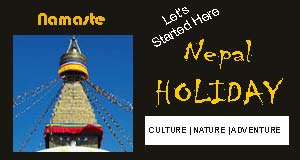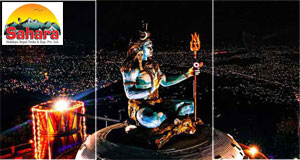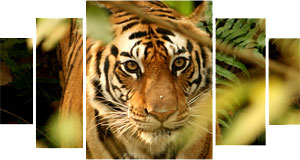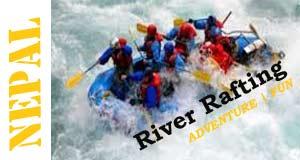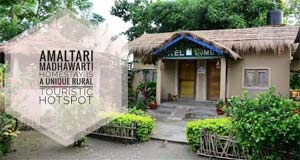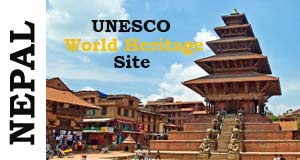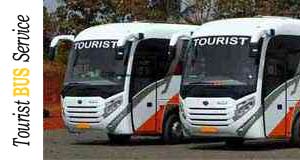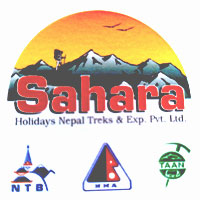Bhutan Package
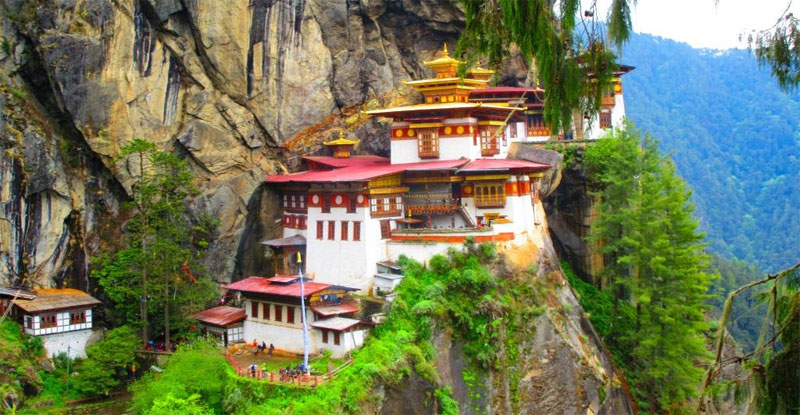 Tiger's Nest Monastery - Eastern Bhutan
Mongar and Lhuentse Dzongkhag - Mongar and Lhuentse, The differences between Eastern and Western Bhutan are far greater than the high pass that separates them. Perhaps like the Scots and the English, there are subtle but marked differences. History has played a significant role with the kingdom only being unified with the east at the end of the last century and prior to that many wars separated each side. The eastern dialect is so different from the western dialect that the two groups find it difficult to understand each other. The journey to the East is one of the most beautiful in all the Himalayas. Rising out of Ura, the highway climbs steeply to Thrumshing La (the second highest pass, 3,800m-12,465ft.) along the West to East highway at Thrumshing La (during the Winter the pass can be closed for several days after heavy snowfalls) where the mountains of east Bhutan can be seen during clear weather. The descent from Thrumshing La to Lingmithang is astonishing for several reasons. The road drops from 3,800 meters to 650 meters in only a few hours passing from pine forest through semi-tropical forest to orange groves. Carved out of the side of the mountain, in parts the road's edge borders a sheer cliff which drops thousands feet. Arriving at Mongar marks the beginning of your eastern Bhutan experience. Many towns in eastern Bhutan are built on the sides of the hills which contrasts to the west where they develop on the valley floor. Mongar Dzong was built in 1953 (original Shongar Dzong was distroyed by fire) on the orders of the Third King, Jigme Dorje Wangchuck. The Royal Guesthouse, Zhonggar Lodge is located near the dzong enjoying a pleasant view from the garden over Mongar Valley.
Some of the finest weaving villages in Bhutan are found outside of Mongar in Lhuentse and Kuri Chhu. These are the traditional 'kushitara' weavers who have been the weavers to the Royal Family for generations.
Trashi Yangste Dzongkhag - Trashi Yangste and Duksum On the drive to Trashi Yangtse you pass the small town of Duksum located on the Drangme Chhu and its tributary. It is a few kilometers past Gom Kora A large boulder sits in the garden of Gom Kora (Gomphu Kora) Temple and its is said that if anyone can climb below the rock and emerge from its summit, he will be forgiven of his sins. Duksum is nothing fancy but it is a small weaver's town where you can find a fair amount of weavers producing some very nice work. The landmark of the town is a original iron chain suspension bridge built by Thangtong Gyalpo or Lama Hazampa (Lama Iron-bridge) in the 1600's. Duksum is the main supply town for all the high mountain villages that surround it.
Trashi Yangtse is a small town rich in Bhutanese arts and legend. Chorten Kora is one of the only two huge stupas/chortens in Bhutan done in the Nepalese 'eye' style. Each Spring Chorten Kora is the sight of one of the most famous festivals in Bhutan. Although quite remote the Chorten Kora Tshechu attracts people from all parts of the country.
A Brief History of Chorten Kora (18th century) : Lama Ngawang Loday wished to construct a replica of the Bodnath stupa in Nepal in memory of his late uncle Lama Jangchhub Gyeltshen and to subdue a demon dwelling at the site where to chorten was to be constructed. Guru Rinpoche and his brothers constructed the Bodnath stupa popularly known as Jarung Khashor in their previous lives.
Lama Ngawang Loday and his friend Lama Zangpo from Tawang, Arunachal Pradesh (India) set on a journey to Bodnath. Both returned with a model of the chorten that was carved from a radish. They were determined to construct similar chortens in Tawang and Trashiyangtse. Lama Zangpo constructed at Pangchanang valley in Tawang, which is known as Gorzam Chorten. Lama Ngawang Loday constructed his on the floor of the Trashiyagtse valley. Twelve years in the construction it is called Chorten Kora. Blessed by HH Je Yonten Thaye, the demon that had harmed the people of the valley was subdued and banished. Thereafter, it is said that the people of the valley continue to live in peace and harmony. The Chorten Kora Festival celebrates this history.
Trashigang Dzongkhag - Trashigang Dzong and Radhi is the eastern-most point on the highway. Eastern residents use Trashigang to trade and the town itself is usually a hive of activity, especially around the bus station where buses are frequently leaving for Thimphu and Paro in the west and Samdrup Jongkhar and India, only a few hours to the southeast. A short distance is Rungjang and Radhi are considered two of Bhutan's most renowned weavering villages. Specializing in natural dyed raw silk textiles. Trashigang is also a melting pot of hill tribe people who come to the town to trade. In particular, the unusual Merak and Sakteng people come to Trashigang to trade yak's butter for the provisions that they need in the mountains. Merak and Sakteng are located about 50 miles east of Trashigang close to the border with India's Arunachal Pradesh.
Trashigang Dzongkhag - Trashigang Dzong and Radhi is the eastern-most point on the highway. Eastern residents use Trashigang to trade and the town itself is usually a hive of activity, especially around the bus station where buses are frequently leaving for Thimphu and Paro in the west and Samdrup Jongkhar and India, only a few hours to the southeast. A short distance is Rungjang and Radhi are considered two of Bhutan's most renowned weavering villages. Specializing in natural dyed raw silk textiles. Trashigang is also a melting pot of hill tribe people who come to the town to trade. In particular, the unusual Merak and Sakteng people come to Trashigang to trade yak's butter for the provisions that they need in the mountains. Merak and Sakteng are located about 50 miles east of Trashigang close to the border with India's Arunachal Pradesh.
Trashigang Dzong sits on a jagged piece of land jutting out from the town and is the first landmark that can be seen from the road winding up to Trashigang. The Dzong was built in 1659 and commands a spectacular view over the valley for which it is the administrative center. The Dzong is significant for the fact that it only has one courtyard.
The university town of Kanlung is located 25 kilometers (16 miles) south of Trashigang. This is the only University of Bhutan, Sherubtse College, founded in 1978.
Bhutan Travel Tips:
Tiger's Nest Monastery - Eastern Bhutan
Mongar and Lhuentse Dzongkhag - Mongar and Lhuentse, The differences between Eastern and Western Bhutan are far greater than the high pass that separates them. Perhaps like the Scots and the English, there are subtle but marked differences. History has played a significant role with the kingdom only being unified with the east at the end of the last century and prior to that many wars separated each side. The eastern dialect is so different from the western dialect that the two groups find it difficult to understand each other. The journey to the East is one of the most beautiful in all the Himalayas. Rising out of Ura, the highway climbs steeply to Thrumshing La (the second highest pass, 3,800m-12,465ft.) along the West to East highway at Thrumshing La (during the Winter the pass can be closed for several days after heavy snowfalls) where the mountains of east Bhutan can be seen during clear weather. The descent from Thrumshing La to Lingmithang is astonishing for several reasons. The road drops from 3,800 meters to 650 meters in only a few hours passing from pine forest through semi-tropical forest to orange groves. Carved out of the side of the mountain, in parts the road's edge borders a sheer cliff which drops thousands feet. Arriving at Mongar marks the beginning of your eastern Bhutan experience. Many towns in eastern Bhutan are built on the sides of the hills which contrasts to the west where they develop on the valley floor. Mongar Dzong was built in 1953 (original Shongar Dzong was distroyed by fire) on the orders of the Third King, Jigme Dorje Wangchuck. The Royal Guesthouse, Zhonggar Lodge is located near the dzong enjoying a pleasant view from the garden over Mongar Valley.
Some of the finest weaving villages in Bhutan are found outside of Mongar in Lhuentse and Kuri Chhu. These are the traditional 'kushitara' weavers who have been the weavers to the Royal Family for generations.
Trashi Yangste Dzongkhag - Trashi Yangste and Duksum On the drive to Trashi Yangtse you pass the small town of Duksum located on the Drangme Chhu and its tributary. It is a few kilometers past Gom Kora A large boulder sits in the garden of Gom Kora (Gomphu Kora) Temple and its is said that if anyone can climb below the rock and emerge from its summit, he will be forgiven of his sins. Duksum is nothing fancy but it is a small weaver's town where you can find a fair amount of weavers producing some very nice work. The landmark of the town is a original iron chain suspension bridge built by Thangtong Gyalpo or Lama Hazampa (Lama Iron-bridge) in the 1600's. Duksum is the main supply town for all the high mountain villages that surround it.
Trashi Yangtse is a small town rich in Bhutanese arts and legend. Chorten Kora is one of the only two huge stupas/chortens in Bhutan done in the Nepalese 'eye' style. Each Spring Chorten Kora is the sight of one of the most famous festivals in Bhutan. Although quite remote the Chorten Kora Tshechu attracts people from all parts of the country.
A Brief History of Chorten Kora (18th century) : Lama Ngawang Loday wished to construct a replica of the Bodnath stupa in Nepal in memory of his late uncle Lama Jangchhub Gyeltshen and to subdue a demon dwelling at the site where to chorten was to be constructed. Guru Rinpoche and his brothers constructed the Bodnath stupa popularly known as Jarung Khashor in their previous lives.
Lama Ngawang Loday and his friend Lama Zangpo from Tawang, Arunachal Pradesh (India) set on a journey to Bodnath. Both returned with a model of the chorten that was carved from a radish. They were determined to construct similar chortens in Tawang and Trashiyangtse. Lama Zangpo constructed at Pangchanang valley in Tawang, which is known as Gorzam Chorten. Lama Ngawang Loday constructed his on the floor of the Trashiyagtse valley. Twelve years in the construction it is called Chorten Kora. Blessed by HH Je Yonten Thaye, the demon that had harmed the people of the valley was subdued and banished. Thereafter, it is said that the people of the valley continue to live in peace and harmony. The Chorten Kora Festival celebrates this history.
Trashigang Dzongkhag - Trashigang Dzong and Radhi is the eastern-most point on the highway. Eastern residents use Trashigang to trade and the town itself is usually a hive of activity, especially around the bus station where buses are frequently leaving for Thimphu and Paro in the west and Samdrup Jongkhar and India, only a few hours to the southeast. A short distance is Rungjang and Radhi are considered two of Bhutan's most renowned weavering villages. Specializing in natural dyed raw silk textiles. Trashigang is also a melting pot of hill tribe people who come to the town to trade. In particular, the unusual Merak and Sakteng people come to Trashigang to trade yak's butter for the provisions that they need in the mountains. Merak and Sakteng are located about 50 miles east of Trashigang close to the border with India's Arunachal Pradesh.
Trashigang Dzongkhag - Trashigang Dzong and Radhi is the eastern-most point on the highway. Eastern residents use Trashigang to trade and the town itself is usually a hive of activity, especially around the bus station where buses are frequently leaving for Thimphu and Paro in the west and Samdrup Jongkhar and India, only a few hours to the southeast. A short distance is Rungjang and Radhi are considered two of Bhutan's most renowned weavering villages. Specializing in natural dyed raw silk textiles. Trashigang is also a melting pot of hill tribe people who come to the town to trade. In particular, the unusual Merak and Sakteng people come to Trashigang to trade yak's butter for the provisions that they need in the mountains. Merak and Sakteng are located about 50 miles east of Trashigang close to the border with India's Arunachal Pradesh.
Trashigang Dzong sits on a jagged piece of land jutting out from the town and is the first landmark that can be seen from the road winding up to Trashigang. The Dzong was built in 1659 and commands a spectacular view over the valley for which it is the administrative center. The Dzong is significant for the fact that it only has one courtyard.
The university town of Kanlung is located 25 kilometers (16 miles) south of Trashigang. This is the only University of Bhutan, Sherubtse College, founded in 1978.
Bhutan Travel Tips:All Foreign National Tourists visiting Bhutan must travel through all inclusive package Tours, for which there is a fixed tariff set by the Royal government of Bhutan. This Tariff includes the Services of accommodation, All meals, Transportation within the country, Guide services, sightseeing and entrance fees for the museums and monuments. Visa Information
All visitors to Bhutan must have a visa approved prior to arriving in the kingdom. Those who have not had a visa approved will not be permitted to board their Druk Air flight to Bhutan. A two-week visa costs US$50/- + USD 10/- Tourism Tax and actual visa stamping in your passport at Paro Airport during the immigration process. Visas are approved and issued prior to entry, with the prepayment of your travel itinerary. Therefore visitors to Bhutan need to finalize their travel plans well in advance. We recommend 30 days. Tourist Attractions:
Trashi Chhoe Dzong | Memorial Chorten | School of Arts and Crafts | Weekend market | Changlimithang Stadium | National Institute of Traditional Medicine | Taktsang (Tiger’s Nest) | Rimpung Dzong | Town of Paro Getting There
By Air: The best way to enter Bhutan is by Druk Air, the national air carrier. Following stations are connected with Druk Air Flight. REVISED Tour Cost for 2024
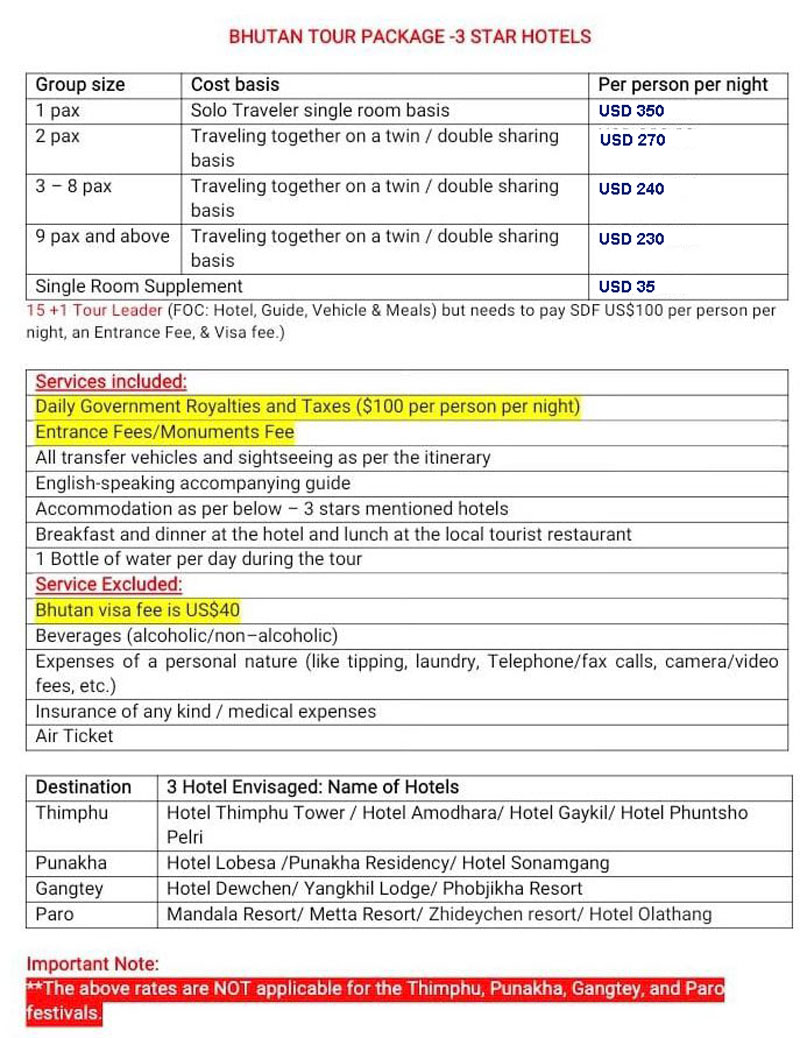 FLIGHT TICKETS: USD 480/- (KTM/PBH/KTM)
Note
FLIGHT TICKETS: USD 480/- (KTM/PBH/KTM)
NoteBy Surface: Entry or exit is also possible through Phuntsoling the southern Bhutanese border town. From here the nearest airport is Bagdogra in West Bengal. For travelers wishing to visit indian states of Sikkim, West Bengal along with Bhutan, Phuntsoling serves as the convenient point. Exit from Bhutan can be also made through Samdrup Jongkhar, an important link for visiting further Northeastern states of India. However, Government rules of Bhutan has made it mandatory to use at least one way by air. Important: Bhutan Tour Package have one single uniform rate per person/per day basis which is fixed by the Govt. of Bhutan. They do not have any Budget/Standard/Deluxe categories, using moderate hotels and all packages are on full board with sightseeing For More information:
Write Us Mail: holidaynepal@gmail.com | Call: +977 9841 911150 Or WhatsApp & Viber +977 9816 770504

